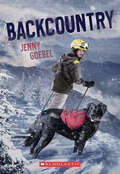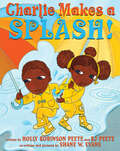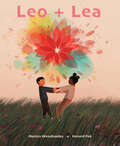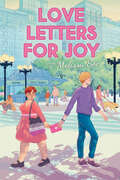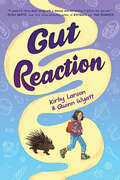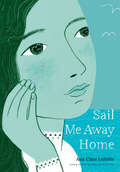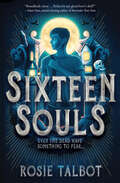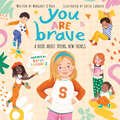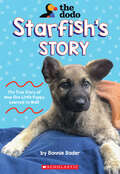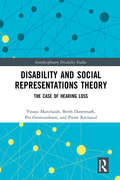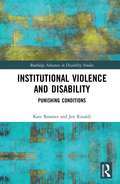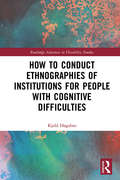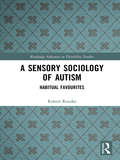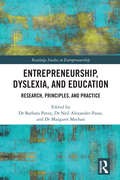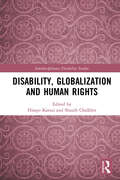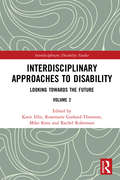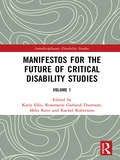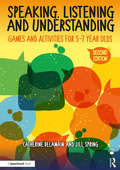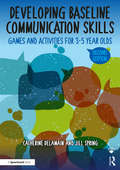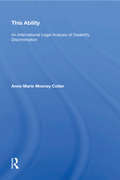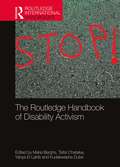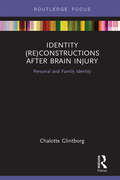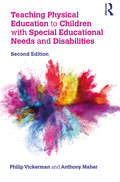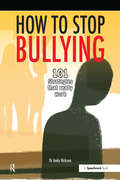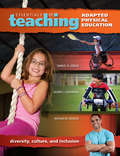- Table View
- List View
Backcountry
by Jenny GoebelA girl and her diabetic alert dog face impossible odds when they're stranded in the unforgiving wilderness. Hatchet for a new generation!Emily has always excelled at sports, and her athletic abilities have given her confidence on and off the courts. Sowhen she starts to drag during her middle school volleyball season, she assumes it must be the flu. Why else would she be missing simple spikes and blocks? But after a particularly intense game she finds herself riding in the back of an ambulance, a paramedic telling her that her life will never be the same.Adjusting to life with type 1 diabetes isn't easy. Emily is desperate to prove that she’s just as strong and capable as ever, so she jumps at the opportunity to go on a backcountry ski trip with her dad and her new diabetic alert dog, Molly.But when an avalanche rips through the area, separating Emily from her father, she and Molly are left to face a challenge far greater than anything she could have imagined. When it becomes clear that no one will come to their rescue before their food and insulin run out, Emily and Molly must find strength they didn't know they possessed -- and faith in one another -- to survive the harsh wintery conditions and escape the backcountry.
Charlie Makes a Splash!
by Shane W. Evans Holly Robinson PeeteThe award-winning team who brought us MY BROTHER CHARLIE presents a companion book that celebrates the power of water for those who have autism. Like many kids on the autism spectrum, Charlie finds solace and empowerment in pools, ponds, sprinklers, visting the aquarium, and swimming in the ocean. Through his adventures and discoveries, he shows the world that even though he has autism, autism doesn't have him. In this beautiful ode to the love between siblings Callie and Charlie, we return to the characters from our award-winning book MY BROTHER CHARLIE, who bring whimsy to everyday fun for all children, while showing readers that kids who may experience the world in different ways can help us see the wonders of swimming to your own rhythm.
Leo + Lea
by Monica WesolowskaOne <P> boy <P> loves numbers. <P> Everywhere he looks <P> he sees things to count. <P> His classmates don’t understand counting as he does. <P> A new girl loves patterns. <P> Could she be <P> a friend <P> for <P> Leo? <P><P> This beautiful friendship story, inspired by the Fibonacci sequence and cleverly constructed using its mathematical pattern, celebrates our differences, as well as how math connects us to one another. <P><P> Young readers will love counting the number of words per page and discovering how they echo the Fibonacci Sequence, a mathematical series in which each number is the sum of the previous two: 0, 1, 1, 2, 3, 5, 8, 13, 21, and so on to infinity! Text and art are masterfully conceived and constructed to reflect Leo’s love of numbers. Even the color scheme in the striking illustrations follows a mathematical progression, bringing an underlying order and tranquility to the story. The mesmerizing symmetry of this fascinating and compulsively playable game of addition can also be found in the natural world and is an intriguing metaphor for the interconnectedness of all things.
Love Letters for Joy
by Melissa SeeA new LGBTQIA+ romance story by the author of You, Me, and Our Heartstrings.Less than a year away from graduation, seventeen-year-old Joy is too busy overachieving to be worried about relationships. She’s determined to be Caldwell Prep’s first disabled valedictorian. And she only has one person to beat, her academic rival Nathaniel.But it’s senior year and everyone seems to be obsessed with pairing up. One of her best friends may be developing feelings for her and the other uses Caldwell’s anonymous love-letter writer to snag the girl of her dreams. Joy starts to wonder if she has missed out on a quintessential high school experience. She is asexual, but that’s no reason she can’t experience first love, right?She writes to Caldwell Cupid to help her sort out these new feelings and, over time, finds herself falling for the mysterious voice behind the letters. But falling in love might mean risking what she wants most, especially when the letter-writer turns out to be the last person she would ever expect.
Gut Reaction
by Kirby Larson Quinn WyattCritically acclaimed, bestselling author and Newbery Honor-winner, Kirby Larson, and her daughter, debut author, Quinn Wyatt, pen this gorgeously moving and often funny story that explores what living with a chronic illness is like. Inspired by Quinn's own personal journey, Gut Reaction is full of heart and humor and highlights the importance of asking for help when it comes to mental and physical health alike.Tess Medina is still dealing with the loss of her father when she starts at a new school. One way she is still able to feel close to him is by doing what she does best: baking. He taught her everything she knows. But when tasting her creations causes a deep stabbing pain in her abdomen, she tries to power through and be strong in the same way she powers through her emotional pain. She doesn’t mind too much--she’s okay with sharing her baked goods at school in the hopes of making new friends.Lucky for Tess, her baking skills attract the right kind of attention, and she assembles a ragtag team to help her taste her new and classic creations in preparation for the Jubilee Flour Junior Baker West Coast competition. This is a chance to redeem herself and prove that she's a star baker. Above all, Tess is desperate to win first place and make her dad proud.But leading up to the competition, Tess's pain gets worse and worse, and, soon, she finds that she's avoiding so many foods that she's barely eating. When the physical pain becomes too great, Tess will be forced to confront everything she has been trying so desperately to hide.From Newbery Honor author Kirby Larson and her daughter, debut author Quinn Wyatt, comes a poignant, sometimes silly, and always moving story of coming to grips with grief and finding the sweet filling inside every treat.Praise for Gut Reaction by Kirby Larson and Quinn Wyatt:"A powerful story about living with a disease and not letting it define who you are."--Alan Gratz, New York Times bestselling author of Refugee and Two Degrees."Kirby Larson and Quinn Wyatt have cooked up a rich, warm story about Crohn's Disease, courage, and cookies. The voice is heartfelt and authentic, leavened with humor and, oh my frog, delicious desserts. Gut Reaction is a wonderful book about important things, and I recommend it highly."--Karen Cushman, author of the Newbery Award-winning The Midwife's Apprentice."A multi-layered, straight-from-the-heart story written with a light, deft touch,Gut Reaction will inspire readers to pursue their creative passions. I loved this touching, sweet, and engaging book!"--Barbara Dee, award-winning author of Unstuck."Sweet and delicious! You will gobble up this book in one bite!"--Jennifer L. Holm, New York Times bestselling author of The Fourteenth Goldfish."Gut Reaction is a much-needed and important book for everyone: those suffering with Crohn's disease, their family and friends who want to help them, and for all the rest who need to understand. Written with the voice of authenticity by a mother/daughter team who know firsthand the effects of this painful and often embarrassing disease. Toss in a handful of lovable and diverse characters and an edge-of-your-seat cooking competition and Gut Reaction is a recipe for success."--Barbara O'Connor, author of How To Steal A Dog and WISH."I would have finished Gut Reaction in one swoop--but I didn't want it to end. I especially loved the baking connection, but the story's honesty, the humor and the friendships added so many layers. If the topic seems serious--and it is, the way Tess struggles to accept her illness will resonate with readers. Tess Medina is an inspiration. Her story will be one you'll remember long after that last page is turned."--Augusta Scattergood, author of Glory Be and The Way To Stay In Destiny."Great British Baking Show meets Guts by Raina Telgemeie
Sail Me Away Home (Show Me a Sign)
by Ann Clare LeZotteThis gripping, stand-alone story, set in the world of the award-winning Show Me a Sign and Set Me Free, completes a unique and unforgettable trilogy that centers the Deaf experience.As a young teacher on Martha's Vineyard, Mary Lambert feels restless and adrift. So when a league of missionaries invite her to travel abroad, she knows it's a once in a lifetime opportunity. Paris is home to a pioneering deaf school where she could meet its visionary instructors Jean Massieu and Laurent Clerc-and even bring back their methods to help advance formal deaf education in America!But the endeavor comes at a cost: The missionaries' plan to "save" deaf children is questionable at best-and requires Mary's support. What's more, the missionaries' work threatens the Wampanoag and other native peoples' freedom and safety. Is pursuing Mary's own goals worth the price of betraying her friends and her own values?So begins a feverish and fraught adventure, filled with cunning characters, chance encounters, and new friendships. Together with Show Me a Sign and Set Me Free, this stunning story will enrich your understanding of Deaf history and culture, and forever alter your perspective on ability and disability.
Sixteen Souls
by Rosie TalbotThe spooky, swoony YA debut by BookTok star Rosie Talbot (@Merrowchild) -- the "TikTok Made Me Buy It" sensation dubbed Heartstoppers with ghosts! Perfect for fans of V. E. Schwab and Aiden Thomas.Sixteen-year-old Charlie Frith has problems. His crush is dating someone else, his sisters have glitter-bombed his prosthesis (again), and he's a seer-of-spirits in York, the most haunted city in England, and all his friends are ghosts. To make matters worse, it seems that famous spirits are mysteriously vanishing from York's haunted streets and alleys. Charlie is determined to stay out of it, but Sam, the irritating new seer in town, expects him to track down who -- or what -- is responsible and uncover the dark purpose behind these disappearances. But when one of Charlie's ghostly friends vanishes, he has no choice but to face the shadows -- and his growing feelings for Sam. The boys must be willing to risk it all to save York’s spirits, because this adversary will stop at nothing to complete their devastating plan. Afterlives are at stake, and Charlie is running out of time ...
You Are Brave: A Book About Trying New Things
by Margaret O'Hair Sofia SanchezAn inspiring and inclusive picture book about overcoming the odds from Down syndrome advocate and viral sensation Sofia Sanchez!Just because you are different, that doesn’t mean you can’t succeed and share your gifts and passion with the world! That is the timely and important message of You Are Brave. This book helps readers learn their own self-worth and encourages kids to overcome obstacles by sticking up for themselves and others, trying new things, and showing the world how brave they are!This companion picture book to 2021’s You Are Enough and 2023’s You Are Loved focuses on dreaming big and overcoming any obstacles that stand in your way. Sofia has Down syndrome, but she hasn’t let that stop her from becoming a successful model, actress, and activist. Sofia is the perfect person to share You Are Brave's message of encouragement and bravery with kids everywhere.
Starfish's Story (The Dodo)
by Bonnie BaderThe true story of how one little puppy learned to walk -- as seen on The Dodo!When Starfish was rescued from a California beach, this Belgian Malinois puppy couldn't stand. That's because Starfish had swimmer puppy syndrome, which meant her leg muscles hadn't developed properly. If Starfish was going to walk, she would need help from a lot of new friends.Luckily, a team of doctors, therapists, and Starfish's family all worked together to encourage and support her. This true story teaches us what it means to never give up hope. With some love, hard work, and a "can-do" attitude, Starfish reached her goals and inspired everyone around her.This story is perfect for middle-grade readers and comes with eight pages of full-color photos!
Disability and Social Representations Theory: The Case of Hearing Loss (Interdisciplinary Disability Studies)
by Berth Danermark Vinaya Manchaiah Per Germundsson Pierre RatinaudDisability and Social Representations Theory provides theoretical and methodological knowledge to uncover the public perception of disabilities. Over the last decade there has been a significant shift from body to environment, and the relation between the two, when understanding the phenomenon of disabilities. The current trend is to view disabilities as the outcome of this interaction; in short from a biopsychosocial perspective. This has called for research based on frameworks that incorporate both the body and the environment. There is a great corpus of knowledge of the functions of a body, and a growing corpus of environmental factors such as perceptions among specific groups of persons towards disabilities. However, there is a lack of knowledge of the perception of disabilities from a general population. This book offers an insight into how we can broaden our understanding of disability by using Social Representations Theory, with specific examples from studies on hearing loss. The authors highlight that attitudes and actions are outcomes of a more fundamental disposition (i.e., social representation) towards a phenomenon like disability. This book is written assuming the reader has no prior knowledge of Social Representations Theory. It will be of interest to all scholars, students and professionals working in the fields of disability studies, health and social care, and sociology.
Institutional Violence and Disability: Punishing Conditions (Routledge Advances in Disability Studies)
by Kate Rossiter Jen Rinaldi"This was several times with that damn cribbage board. I hate cribbage boards to this very day. They never beat us on the arms or legs or stuff, it was always on the bottom of the feet, I couldn't figure it out." Brian L., Huronia Regional Centre Survivor Over the past two decades, the public has borne witness to ongoing revelations of shocking, intense, and even sadistic forms of violence in spaces meant to provide care. This has been particularly true in institutions designed to care for people with disabilities. In this work, the authors not only describe institutional violence, but work to make sense of how and why institutional violence within care settings is both so pervasive and so profound. Drawing on a wide range of primary data, including oral histories of institutional survivors and staff, ethnographic observation, legal proceedings and archival data, this book asks: What does institutional violence look like in practice and how might it be usefully categorized? How have extreme forms violence and neglect come to be the cultural norm across institutions? What organizational strategies in institutions foster the abdication of personal morality and therefore violence? How is institutional care the crucial "first step" in creating a culture that accepts violence as the norm? This highly interdisciplinary work develops scholarly analysis of the history and importance of institutional violence and, as such, is of particular interest to scholars whose work engages with issues of disability, health care law and policy, violence, incarceration, organizational behaviour, and critical theory.
How to Conduct Ethnographies of Institutions for People with Cognitive Difficulties (Routledge Advances in Disability Studies)
by Kjeld HøgsbroThis book provides a comprehensive analysis of the methodological, theoretical, and meta-theoretical considerations and guidelines involved in undertaking institutional ethnographic work involving people with cognitive and communicative disabilities. It presents a coherent platform for integrating theory and method built on classical and recent anthropological and sociological theory as well as classic and recent methodological considerations within the ethnographic tradition. Furthermore, it introduces readers to the challenging work of understanding the lifeworld of people who cannot express themselves in ordinary ways or who are deeply stigmatised and oppressed by dominating discourses telling them how to understand and define their role in society. It will be of interest to all scholars, students and researchers of disability studies, particularly those who undertake ethnographic research or want to understand the challenges involved in doing so.
A Sensory Sociology of Autism: Habitual Favourites (Routledge Advances in Disability Studies)
by Robert RourkeThis innovative book places the sensory experiences of autistic individuals within a sociological framework. It instigates new discussions around sensory experience, autism and how disability and ability can be reconceived. Autism is commonly understood to involve social and communication difficulties. Less commented upon is the sensory challenges faced by those with autism. Sociology is no different, focusing on communication and neglecting the sensory dimensions of experience. Sensory experiences and relations are central to how we understand and navigate through the natural and social worlds, and mediate our interactions with other people, objects and spaces. In this book, the author explores how these processes are affected by the favourite activities of autistic people. With real-life case studies and cutting-edge research, this book will be useful to students, autistic people, advocates and carers, disability studies researchers and sociologies of disability and the senses.
Entrepreneurship, Dyslexia, and Education: Research, Principles, and Practice (Routledge Studies in Entrepreneurship)
by Barbara PaveyThe development of entrepreneurial abilities in people with dyslexia is a subject of great interest. It has gained increasing importance in economically difficult times because of its potential for the development of new business opportunities. This book brings together contributions from researchers, educators, and entrepreneurs with dyslexia, investigating this subject from many perspectives. Is there something different in the profile of a person with dyslexia that supports the development of entrepreneurship? This book aims to draw out key themes which can be used in education to motivate, mentor, and create the business leaders of tomorrow. It offers a fundamental text for this area of study with a comprehensive, international examination of its topic. It includes views by new and established international writers and researchers, providing up-to-date perspectives on entrepreneurship, dyslexia, and education. It is accessible to read, to understand, and to learn from, and is suitable for recommended reading for graduate and postgraduate students. The diverse views and perspectives demonstrated in this book make it as relevant as possible for a wide group of readers. It informs study in the fields of business and dyslexia, and will be of interest to educators, researchers, and to anyone interested in the overlap of entrepreneurship and dyslexia.
Disability, Globalization and Human Rights (Interdisciplinary Disability Studies)
by Hisayo KatsuiThe UN Convention on the Rights of Persons with Disabilities has facilitated the understanding that disability is both a human rights and development issue. In order to achieve the Sustainable Development Goals by 2030, the focus on disability inclusion has become increasingly important in the discourse of international and national efforts for "leaving no one behind", the motto of the SDGs. This book discusses pertinent and emerging themes such as disability rights, globalization, inequalities, international cooperation and representation. Evidence which has been obtained tends to show that persons with disabilities have been disproportionately left behind without proper representation, participation and inclusion. This book critically investigates the gaps at different levels, from top to bottom, and as importantly, within the global disability movement, for the realization of global disability rights, and theorizes the intersection of disability, globalization and human rights. Empirical case studies from different countries and contexts are introduced to deepen analysis on theories of critical disability studies from a global perspective. Co-edited by a disability researcher and the former United Nations Special Rapporteur on Disability, this book will be of interest to all students, academics, policy makers and practitioners working to advance the cause of disability rights around the world.
Interdisciplinary Approaches to Disability: Looking Towards the Future: Volume 2 (Interdisciplinary Disability Studies)
by Rosemarie Garland-Thomson Rachel Robertson Katie Ellis Mike KentHow can a deep engagement with disability studies change our understanding of sociology, literary studies, gender studies, aesthetics, bioethics, social work, law, education, or history? Interdisciplinary Approaches to Disability (the companion volume to Manifestos for the Future of Critical Disability Studies) identifies both the practical and theoretical implications of such an interdisciplinary dialogue and challenges people in disability studies as well as other disciplinary fields to critically reflect on their professional praxis in terms of theory, practice, and methods. Topics covered include interdisciplinary outlooks ranging from media studies, games studies, education, performance, history and curation through to theology and immunology. Perspectives are drawn from different regions from the European Union to the Global South with chapters that draw on a range of different national backgrounds. Our contributors who write as either disabled people or allies do not proceed from a singular approach to disability, often reflecting different or even opposing positions. The collection features contributions from both established and new voices in international disability studies outlining their own visions for the future of the field. Interdisciplinary Approaches to Disability will be of interest to all scholars and students working within the fields of disability studies, cultural studies, sociology, law history and education. The concerns raised here are further in Manifestos for the Future of Critical Disability Studies.
Manifestos for the Future of Critical Disability Studies: Volume 1 (Interdisciplinary Disability Studies)
by Rosemarie Garland-Thomson Rachel Robertson Katie Ellis Mike KentThis collection identifies the key tensions and conflicts being debated within the field of critical disability studies and provides both an outline of the field in its current form and offers manifestos for its future direction. Traversing a number of disciplines from science and technology studies to maternal studies, the collection offers a transdisciplinary vision for the future of critical disability studies. Some common thematic concerns emerge across the book such as digital futures, the usefulness of anger, creativity, family as disability allies, intersectionality, ethics, eugenics, accessibility and interdisciplinarity. However, the contributors who write as either disabled people or allies do not proceed from a singular approach to disability, often reflecting different or even opposing positions on these issues. Containing contributions from established and new voices in disability studies outlining their own manifesto for the future of the field, this book will be of interest to all scholars and students working within the fields of disability studies, cultural studies, sociology, law, history and education. The concerns introduced here are further explored in its sister volume Interdisciplinary approaches to disability: looking towards the future.
Speaking, Listening and Understanding: Games and Activities for 5-7 year olds (The Good Communication Pathway)
by Catherine Delamain Jill SpringSpeaking, Listening and Understanding is a practical resource packed full of games to improve young children’s communication skills. The second edition of this bestselling resource contains a programme of games and activities to foster the speaking, listening and understanding skills of children aged from 5 to 7 years. The book seeks to address language and communication difficulties for primary-aged children by providing a range of fun and engaging activities. Suitable for whole classes or small groups of children, the activities focus on both understanding and using language in areas such as following instructions, thinking skills, inference, describing, narrating and playing with words. Features include: 160 games and activities which are differentiated by stages and levels of ability; A clear aim, equipment list and instructions for each activity; Photocopiable templates for ease of use; Supplementary resource sheets including pictures and scripts to use with the activities. Now fully revised and updated in line with current policy and legislation, this book is suitable for young children in any school setting. It also includes material that may be used as an effective part of a speech and language therapy programme in consultation with a therapist. This is a unique manual that will be an essential addition to the materials used by professionals working with young children.
Developing Baseline Communication Skills: Games and Activities for 3-5 year olds (The Good Communication Pathway)
by Catherine Delamain Jill SpringDeveloping Baseline Communication Skills is a practical resource designed to fit with baseline assessments in primary school. The second edition of this bestselling resource contains a programme of games and activities to foster personal and social development, and promote language and literacy skills in 3–5 year olds. The book seeks to address language and communication difficulties for children coming into reception class by providing a range of fun and engaging activities. Suitable for whole classes or small groups of children, the activities focus on both personal, social, emotional development as well as language and literacy in areas such as body language, independence, turn taking, listening, speaking and auditory memory. Features include: 200 games and activities which are differentiated for different ages and levels of ability; A clear aim, equipment list and instructions for each activity; Photocopiable templates for ease of use; Supplementary resource sheets including pictures and scripts to use with the activities. Now fully revised and updated in line with current policy and legislation, this book is suitable for young children in any school setting including nurseries, playgroups and reception classes. It also includes material that may be used as an effective part of a speech and language therapy programme in consultation with a therapist. This is a unique manual that will be an essential addition to the materials used by professionals working with young children.
This Ability: An International Legal Analysis of Disability Discrimination
by Anne-Marie Mooney CotterThis Ability is Cotter's third book in a series dealing with discrimination law. Having looked at the theme of 'gender discrimination' in Gender Injustice and 'race discrimination' in Race Matters, this further installment takes a similar approach and structure to illustrate comparisons and contradictions in discrimination law. Disability Law is an increasingly important area in combating disability discrimination. This Ability provides readers with a better understanding of the issue of inequality and aims to increase the likelihood of achieving equality at both the national and international levels for those with disabilities while at the same time educating those without disabilities. The work examines the primary role of legislation and its impact on the court process. It also discusses the two most important trade agreements of our day - namely the North American Free Trade Agreement and the European Union Treaty - in a historical and compelling analysis of discrimination. By providing a detailed examination of the relationship between disability issues and the law, this book will be an important read for those concerned with equality.
The Routledge Handbook of Disability Activism (Routledge International Handbooks)
by Maria Berghs Tsitsi Chaitaka Yayha El-Lahib Andrew DubeThe onslaught of neoliberalism, austerity measures and cuts, impact of climate change, protracted conflicts and ongoing refugee crisis, rise of far right and populist movements have all negatively impacted on disability. Yet, disabled people and their allies are fighting back and we urgently need to understand how, where and what they are doing, what they feel their challenges are and what their future needs will be. This comprehensive handbook emphasizes the importance of everyday disability activism and how activists across the world bring together a wide range of activism tactics and strategies. It also challenges the activist movements, transnational and emancipatory politics, as well as providing future directions for disability activism. With contributions from senior and emerging disability activists, academics, students and practitioners from around the globe, this handbook covers the following broad themes: • Contextualising disability activism in global activism • Neoliberalism and austerity in the global North • Rights, embodied resistance and disability activism • Belonging, identity and values: how to create diverse coalitions for rights • Reclaiming social positions, places and spaces • Social media, support and activism • Campus activism in higher education • Inclusive pedagogies, evidence and activist practices • Enabling human rights and policy • Challenges facing disability activism The Routledge Handbook of Disability Activism provides disability activists, students, academics, practitioners, development partners and policy makers with an authoritative framework for disability activism.
Identity: Personal and Family Identity (Interdisciplinary Disability Studies)
by Chalotte GlintborgIdentity (Re)constructions After Brain Injury: Personal and Family Identity investigates how being diagnosed with acquired brain injury (ABI) impacts identity (re)construction in both adults with ABI and their close relatives. To show how being diagnosed with ABI impacts identity (re)construction, this book investigates key patterns of identity construction. Discourse analysis, especially on the concept of positioning, provides an understanding of the changes and developmental processes in these self-narratives. These narrative (re)constructions point to a developmental change of identity in the course of the different phases of the recovery process for both persons with ABI and their relatives, including conflicting voices from society, service providers, relatives, and other adults with ABI. In addition, the (re)construction process is characterized by much ambivalence in both ABI survivors and relatives. Three perspectives are triangulated: (1) an insider perspective from ABI survivors; (2) an insider perspective from relatives; and (3) an outsider perspective from the researchers. This allows us to see how identities are negotiated and constructed in concrete situations. This innovative book will be required reading for all students and academics working in the fields of disability studies, rehabilitation psychology, sociology, allied health, and social care.
Teaching Physical Education to Children with Special Educational Needs and Disabilities
by Philip Vickerman Anthony MaherTeaching Physical Education to Children with Special Educational Needs and Disabilities provides a thorough overview of the challenges and opportunities for inclusion in PE lessons. Combining a theoretical framework with practical strategies for teachers, the title covers a diverse range of issues which teachers need to address to provide high quality learning experiences for children with SEND. This second edition is grounded in up-to-date research on inclusion and has been fully updated in line with the SEND Code of Practice and Ofsted Inspection Framework. It seeks to demystify the statutory responsibilities placed upon teachers and schools to include children with SEND and offers practical examples of how PE teachers can make use of different strategies to differentiate through their planning and assessment. A new chapter explores the importance of consulting with and empowering children with SEND, and additional focus is given to how teachers can work together with SENCOs and LSAs to develop an inclusive culture in PE lessons. Written in an accessible style with reflective tasks in each chapter, this unique text clearly outlines relevant practice-based evidence to fully include children with SEND in PE lessons. This will be essential reading for teachers and school leaders and will enable PE teachers to plan and deliver inclusive lessons for all children.
How to Stop Bullying: 101 Strategies That Really Work
by Andy HicksonThis book includes 101 tried-and-tested strategies to deal with bullying. This is a practical workbook full of information and ideas on how to stop being bullied. It contains 101 ideas grouped into five sections: practical and everyday ideas; longer term ideas; cyberbullying; fun ideas; and advanced techniques. In addition, there is information on creating and updating an anti-bullying policy, warm-up games and activities for groupwork, as well as stories of bullying and their resolutions. This is an extremely useful resource for people who get bullied, teachers, health care professionals and parents. Suitable for all ages. Andy Hickson is Director of Actionwork UK. Andy is a theatre Director and has had shows performed at the Globe, Sadlers Wells, Norwich Playhouse and many venues abroad. Andy specialises in using creative action methods to explore violence and other issues. Andy is also a filmmaker and was a runner-up in the 2008 Motorola film competition. Writing credits include Creative Action Methods in Groupwork which is translated into Polish and Japanese, and The Groupwork Manual (also published by Speechmark) and numerous articles and chapters. Andy is currently finishing off his PhD in education.
Essentials of Teaching Adapted Physical Education: Diversity, Culture, and Inclusion
by Lauren Lieberman Nathan Murata Samuel HodgeEssentials of Teaching Adapted Physical Education: Diversity, Culture, and Inclusion offers a wealth of knowledge for teaching today's diverse student population, including those with disabilities. Readers will learn how to teach a variety of students, organize learning within various curricular models, assess and evaluate students, and manage behavior. Readers will also learn more about the conditions and disabilities they may encounter when teaching, how to understand students' various abilities, and how to adapt and modify instructional methods to include all students.The book emphasizes the importance of being culturally responsive and acquiring the necessary knowledge to infuse appropriate, socially just practices into educational settings. Future teachers will learn how to apply culturally responsive instructional methods and behavior management strategies and will understand broader social and economic contexts for their students' behavior.At the same time, this book provides more than a how-to approach to teaching adapted physical education. Its content and features promote reflective learning, encouraging readers to anticipate the types of teaching situations and challenges that may arise and think through how they will respond. Scenarios and vignettes throughout provide context for the material and promote critical thinking and problem solving.
